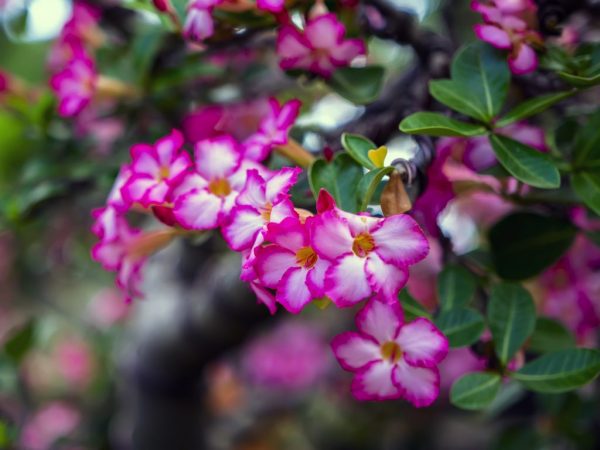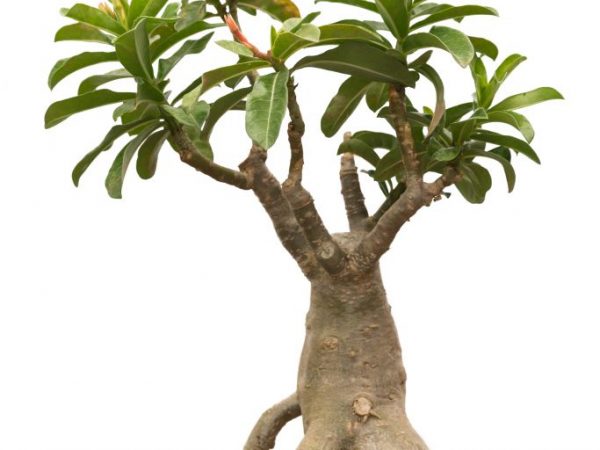Exotic Adenium - the intricacies of transplanting at home
Timely transplantation of Adenium is one of the fundamental active development of a succulent with an unusual external characteristics. This procedure requires the florist to know about the rules for its implementation, the observance of which will ensure abundant flowering and crop growth.

Exotic Adenium - the intricacies of transplanting at home
Soil selection
Like most succulents, Adenium feels most comfortable in loose soil with a high degree of air and water permeability. It is preferable to take coconut substrate or leafy soil as the main component of the soil, which should be supplemented with a special baking powder. In the role of the latter, the following can be used:
- river sand;
- fine-fraction chipped brick;
- seramis (clay soil of natural origin, often used for planting orchids);
- orchiata (natural bark in granules);
- perlite / vermiculite;
- aquarium stones.
Additionally, vermicompost, manure or vegetable humus are introduced into the composition. At the same time, the ratio of the main component and the secondary part directly depends on the conditions of keeping Adenium.
The principle of preparing a soil mixture in relation to the climate:
- At a constant high temperature throughout the year, the bulk is 70%, baking powder and fertilizers - 30%.
- In the case of hot summers and frosty winters, the components are mixed in proportions 1: 1.
This approach is due to the fact that in a cold microclimate, the substrate dries out much worse, which leads to decay of the root system. Therefore, you should not be zealous with baking powder in this situation.
Also, for the development of Adenium, it is important to have a drainage layer, for the creation of which foam plastic, chipped brick or expanded clay are suitable. Charcoal for these purposes is applicable only when transplanting young seedlings, river pebbles are categorically contraindicated for any specimens. Sharp-edged materials should also be used carefully, as they can damage the roots and become entangled in them in the process.
Recommended soil mixture composition:
- leafy land;
- baking powder;
- fertilizers.
Pot selection
The choice of which flowerpot for growing Adenium at home to give is a matter of choice for each grower. Containers made of any material are suitable for a succulent, but it should be borne in mind that the root system of the plant is quite powerful. Under its pressure, a clay pots can crack, while a plastic one at the first stage only deforms, which will become a signal for action. At the same time, containers made of natural clay are better permeable to moisture and oxygen.
The container should be larger than the earthen lump, but in moderate proportions. If the pot is too large, the succulent will stop developing until it has completely mastered the soil.
In most cases, a shallow, wide vessel is suitable, however, for growing such a variety as Adenium Somali, the exact opposite is chosen due to the peculiarities of the root system, which has a vertical arrangement.
In order to choose the right container, experienced florists recommend taking the one in which the distance from the walls to the caudex in adult plants will be 7-8 cm, in adolescents 4 cm, in seedlings - 2-3.
How to transplant correctly
The first plant transplant is done immediately after purchase. In commercial mixes and transport pots, the succulent does not have the opportunity to actively develop, because the soil is universal and does not contain the necessary components for the flower.
The second time, the procedure is carried out taking into account the age of the culture. Young specimens move annually, adults every 2-3 years. This approach is due to the fact that despite the slow growth from the moment of emergence to 2.5 months, after that there is a sharp leap in development, lasting throughout the season.
The optimal time for the event is winter or early spring, when the tree has not yet entered the growing season.
In an emergency, work can be postponed to the summer, but in this case it is worth finishing them a month before autumn, when temperatures are characterized by a strong drop.

It is recommended to replant the plant in spring.
Technology:
- An earthen ball is poured abundantly a few days before the procedure, which ensures easy removal from the container.
- Holding gently by the stem and tilting the pot, they take out the plant.
- Carefully examine the root system for damage and rot. If such are found, the injured segments are trimmed, sprinkled with wood ash, slightly dried. It is also allowed to use Tiovit Jet or colloidal sulfur as a disinfectant.
- The bottom of the container is filled with drainage a few centimeters in height, a little sand is poured on top.
- Part of the soil is laid out with the expectation that the root system should be located 1-3 cm higher than in the previous container. In seedlings, the old soil is not eliminated, adult specimens are cleaned not only from the substrate, which often takes place without outside participation, but also lime traces on the rhizome.
- The plant is carefully placed, fixed with wooden skewers around the perimeter, relative to which it is supposed to create the necessary caudex shape. At the same time, the roots are straightened in the most favorable position according to the grower, the capillary roots are left intact - over time they will disappear themselves.
Care
The transplanted Adenium needs competent care, which in some aspects differs from the standard one. At the same time, the season of the year, the microclimate of the room and the stage in which the culture resides are of great importance.
Lighting
At first, the culture is placed in a moderately lit place so that the flower is exposed not to direct, but to scattered rays of the sun. At the end of the adaptation period, the pot is transferred to the southern windowsill, shading in summer from direct sunlight in order to avoid burns of caudex and leaves.
Watering
Do not rush to water the succulent immediately after the procedure. In case of cloudy weather, no irrigation is done. If the plant looks completely healthy, the soil is moistened, adhering to the requirements of the exotic:
- Abundant in the stage of active growth. In this case, liquids are used more with an increase in temperature indicators. During the summer months, the substrate should always remain moist.
- During a cold snap, the frequency of watering is reduced so as not to provoke the start of decay processes.
Humidity and temperature
Two factors that are directly related to each other. In the absence of damage on the caudex, it is allowed to moisten the plant from a spray bottle several times a day.
The optimum temperature for the comfortable growth of the succulent is 30-35 ° C, a decrease by 5 divisions does not cause discomfort. At the same time, prolonged cooling to 20 ° C leads to a suspension of growth and refusal to form flower ovaries.
Top dressing
Fertilization begins 30 days after transportation into a new planter. These manipulations can accelerate development, increase decorative effect and enhance immunity to pests and diseases.
In the growing and flowering phase, the plant is fed once every 1.5-2 weeks, from autumn to March, an interval between procedures of 1 month is maintained.
Among the drugs, Siliplant, GHE, Advanced Hydroponics, Orton-Gumat are most often used.
Pest and disease control
Even minor deviations from the recommended maintenance standards can cause diseases or pests. Among insects parasitizing on exotic, aphids, spider mites and worms are most often found. If they are found, the culture should be immediately treated with fungicides.
Of the ailments, root rot is considered the most common, resulting from abundant watering, especially if they are accompanied by a decrease in temperature. A solution to the problem is a re-transplant with cutting off the affected segments.
Formative pruning
They resort to manipulations if there is a desire to make a real bonsai out of Adenium. As a result, the number of leaf plates increases, additional lateral processes are formed, and a large number of buds are formed. To achieve the effect, the apical parts of the shoots are shortened by 5-8 cm every few years.
Possible problems
In the course of growing Adenium at home after transplantation, flower growers often face several problems:
- Diseases of the root system and caudex. The reasons may be mechanical damage, an increased level of substrate moisture, hypothermia. The situation is corrected by reloading into a new container. The damaged roots are pre-docked, the cut sites are treated with a fungicidal preparation and dried. After that, they closely observe the culture.
- Suspension of development, lack of flowering - and, as a result, improperly selected soil.

